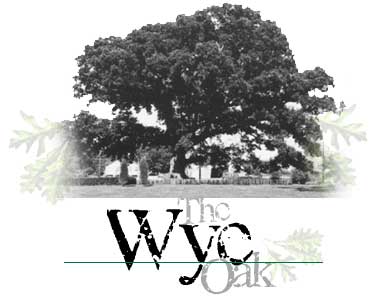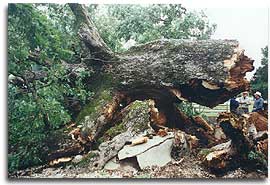The Wye Oak
By M. Stark McLaughlin

In 1977, a group of tree care professionals were asked to conduct an appraisal of the then 400-year-old Wye Oak, located in Wye Mills, Maryland. The tree was well known and documented as one of the largest and perhaps the oldest living white oak in the country. The tree was described as a “magnificent giant” of “spectacular proportions.”
 “Fair” condition
“Fair” condition
The tree had been maintained over the years by State Forest and Park Service personnel, and through contracted labor for feeding, pruning and cabling. The first cables were installed in 1953, shortly after the first of the largest limbs crashed to the ground on October 6th during a thunderstorm. A subsequent limb fell on August 28, 1955 after the cables were rendered slack by a hurricane earlier that summer. The final document prepared by the team of consulting arborists described the tree as being in fair condition: “It has a center core heartwood rot pocket. Thus it may be susceptible to wind throw and trunk breakage. It has had a constant maintenance program, being pruned and fertilized every two years. Its cabling system is extensive and properly done. One problem does arise in that it may become too top heavy and collapse at some future time.”
The report concluded by stating, “This species of tree is capable of living to a thousand years and that the Wye Oak, with an established maintenance program, can probably be preserved for another 200 years. Having carefully considered information and data pertinent to this tree’s size, species, condition, location and other arboricultural factors, it is our opinion that the value of this tree is $35,000.”
Since the 1977 appraisal, the tree continued to be maintained and cared for. In June 1984 the next limb fell. The material was collected by Forest and Park employees including Robert Taylor, Joe Reinhardt, James Hughes, Lee Blades and Paul Furbush. The largest piece was carved into the statue of two children planting a tree which graces the lobby of the Tawes State Office Building in Annapolis. The artwork resided in an outdoor display at Martinak State Park for several years and began to deteriorate from exposure. The piece has been completely restored and is a treasure to see and appreciate.
 A great one falls
A great one falls
On June 6, 2002, that “some future time” arrived. The Wye Oak, which had stood watch over a woodland trail used by the original north Americans, colonial expansion and modern day changes, was buffeted by heavy summer winds as thunderstorms and lightening lashed the area. The thunder and lighting of old led the ancient Greeks to consecrate the oaks to Zeus; the Norse held the oak as a sacred tree powerful and withstanding of the storms. The priests of the Celts were known as Druids, a word derived from a root which signifies a tree, specifically the oak in several Aryan languages.
So the mighty oak fell, and “all the king’s horses and all the king’s men couldn’t put it back together again.”
 Honoring her spirit
Honoring her spirit
The Wye Oak was for many people a very special tree. Foresters, farmers, townspeople, school children, citizens of Maryland and visitors from many nations had marveled at the giant of Wye Mills. Its effect on people varied. Some expected something bigger or grander. Sometimes an individual would just lie down under the spreading branches and reflect on the sunlight piercing the crown of the tree. The tree gave us a sense of time, a sense of scale and stood as a symbol of strength and longevity.
In 1799, William Blake penned, “The tree which moves some to tears of joy is in the eye’s of others only a green thing that stands in the way. Some see Nature all ridicule and deformity, and some scarce see Nature at all. But to the eyes of the man of imagination, Nature is Imagination itself.” The Wye Oak stimulated and moved our imaginations.
As someone who spent nearly 30 years caring for the Wye Oak, I was impressed and moved by the thousands of visitors to the site in the aftermath of the storm. People came for days to say their final goodbyes. Many of their stories were very personal:
“My dad used to stop here every time we came to the Eastern Shore when we were kids. He loved to see this tree, he’s gone now and so is this beautiful tree, it means so much to me now too.”
“We got married under this tree.”
“It’s like a part of my heart is gone.”
Some people cried, some prayed, most left the site with a sense of loss and held on to a twig or a leaf, to be saved, pressed in some favorite book. Perhaps they will pass the leaf on to a loved one or share it with a child at some future date.
An 80-year old Allegany County woman wrote of her memorable visit to the Wye Oak more than 40 years ago, thanking us for taking care of the treasure that had made such a lasting impression. Her letter reminded us that every birth is inevitably followed by a passing, and enclosed a photograph of a cherished wooden cross given her by a dear friend. Crafted from a Wye Oak branch, the cross had been presented by Governor Theodore McKeldin in the 1950s.
My special remembrance from that night in June occurred just shortly after the Wye Oak had fallen. It was still raining tears from the sky. A man of American Indian heritage approached Park Manager John Ohler and me and asked if he could go over and touch the tree. We were just beginning to secure the area; it was still dangerous, wet and confusing. I sensed his need and the depths of his desire and said “yes.” I then escorted him into the mass of tangled branches and limbs. As he knelt down and placed his hands on the fallen tree he chanted. I don’t know what he said but with great reverence and respect he honored the spirit of the Wye Oak and we both understood what this tree was worth.
Glandifer maxine generis omnes, quibus honosmapud Romanos perpertuus.
Translation: Mast-bearing trees were they principally which the Romans held in chiefest reputation. Plinius Secundus (AD 23-79), Roman Nobleman & Historian known as Pliny the Elder.
- Re-printed from The Natural Resource Magazine, Fall 2002.